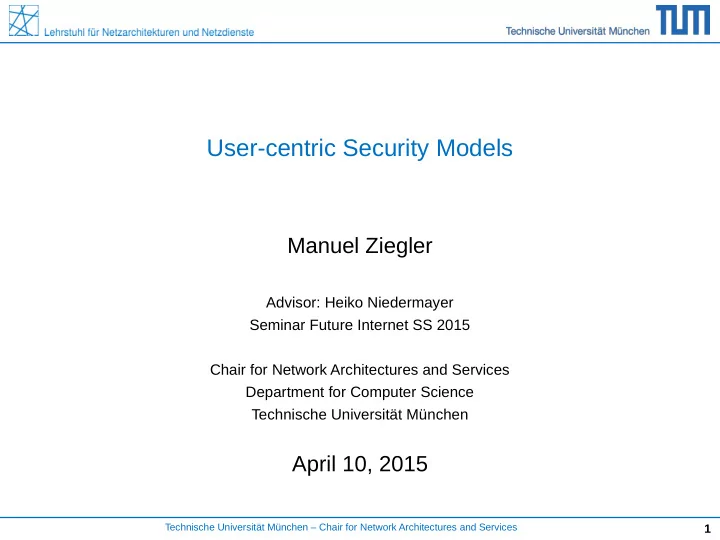

User-centric Security Models Manuel Ziegler Advisor: Heiko Niedermayer Seminar Future Internet SS 2015 Chair for Network Architectures and Services Department for Computer Science Technische Universität München April 10, 2015 Technische Universität München – Chair for Network Architectures and Services 1
Outline Introduction 1) Direct trust and well known decentralized trust models 2) Trust Establishment 3) Trust Decisions 4) Trust Metrics 5) Conclusion 6) Technische Universität München – Chair for Network Architectures and Services 2
Introduction Centralized CA models: TLS, S/MIME Tree based certificate chain Certificate Authority tells you, who to trust CAs are paid for signing certificates root certificate (CA) TLS certificate TLS certificate S/MIME certificate example.com example.de John Doe Technische Universität München – Chair for Network Architectures and Services 3
Introduction The user-centric approach: Not just tree alike trust chains User decides by his own, who to trust Difficult decision making for less experienced users When used correctly: Better trustworthiness than CA based Trust Alice Bob Chuck Carol Dan Technische Universität München – Chair for Network Architectures and Services 4
Direct and well known decentralized Trust Models Direct trust model: Personal meeting between users required Does not scale Can be combined with decentralized trust models Some applications provide the direct trust model retrospectively: – TextSecure – PGP Technische Universität München – Chair for Network Architectures and Services 5
Direct and well known decentralized Trust Models OpenPGP / GnuPG: Public key servers – everybody can modify entries Trust Signatures Privacy Problem: Social environment can be determined from trust signatures Often Trust is established with the help of CA models (Fingerprint on TLS encrypted Website) SSH: Local key database Trust on first connection Similar Concept: Certificate Pinning in Web browsers Technische Universität München – Chair for Network Architectures and Services 6
Trust Establishment Trust Chains: Usually given as graph structures Rating of trust relationships possible Trust Relationships can be derived from a trust chain Technische Universität München – Chair for Network Architectures and Services 7
Trust Establishment Trust-Rated Authentication in domain structured networks: Trust Token with meta information is obtained from a Domain Authentication Server (Holz, et al. 2008 [1]) – Key exchange information – Known frauds – Previous contacts Technische Universität München – Chair for Network Architectures and Services 8
Trust Establishment Trust Establishment with the help of a councelor: PGP – Alice obtains the certificate from Bob through Carol (signed) – Bob obtains the certificate from Alice through Carol (signed) Technische Universität München – Chair for Network Architectures and Services 9
Trust Establishment Trust Establishment with the help of a councelor: Trust Exchange Protocol (Kinkelin, et al. 2014 [2]) Technische Universität München – Chair for Network Architectures and Services 10
Trust Decissions Trustworthiness and reputation: Reputation = Users Assessment of another user's ability to validate the identity of other users (Kinkelin, et al. 2014 [2]) Often Coupled with trustworthiness Supporting the decision making process: Collect Information Categorize Evaluate Display Examples: Web of Trust Browser Plugin, OTO – Online Trust Oracle (Kim, et al. 2012 [3]) Technische Universität München – Chair for Network Architectures and Services 11
Trust Decissions Source: Kim, et al. 2012 [3] Technische Universität München – Chair for Network Architectures and Services 12
P 1 = A → B → E Trust Metrics P 2 = A → C → E P 3 = A → D → F → E P = e 1 ⋅ ... ⋅ e k n k ∑ ∏ e i, j j = 1 i = 1 T = n T = 0,8 ⋅ 0,3 + 0,6 ⋅ 0,7 + 0,9 ⋅ 0,8 ⋅ 0,9 3 T = 0,24 + 0,42 + 0,648 3 T = 0,436 Technische Universität München – Chair for Network Architectures and Services 13
Trust Metrics IL = Identification Level RL = Reputation Level IL CI ⋅ RL RC ⋅ IL RC ∑ RL max IL max C ∈ Councelors IL RI = ⋅ d ∣ Counselors ∣ Kinkelin, et al. 2014 [2] Technische Universität München – Chair for Network Architectures and Services 14
Conclusion Many different decentralized trust models Few user supporting trust decision systems Decentralized Trust models require expert knowledge Most global infrastructure based on CA based models → Still a lot work to do Technische Universität München – Chair for Network Architectures and Services 15
References [1] R. Holz, H. Niedermayer, P. Hauck, and G. Carle: Trust rated authentication for domain structured distributed systems , Public Key Infrastructure – 5th European PKI Workshop: Theory and Practice, 2008 [2] H. Kinkelin, H. Niedermayer, S. Mittelberger, and G. Carle: Human-centric and privacy protecting trust establishment over the internet , CENTRIC: The Seventh International Conference on Advances in Human-oriented and Personalized Mechanisms, Technologies, and Services, 2014 [3] T. H.-J. Kim, P. Gupta, J. Han, E. Owusu, J. Hong, A. Perrig, and Debin: OTO: Online Trust Oracle for user-centric trust establishment , ACM conference on Computer and communications security, 2012 Technische Universität München – Chair for Network Architectures and Services 16
Questions Technische Universität München – Chair for Network Architectures and Services 17
Recommend
More recommend